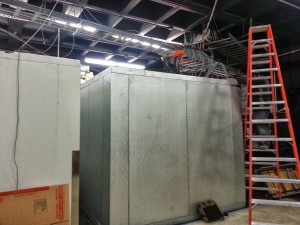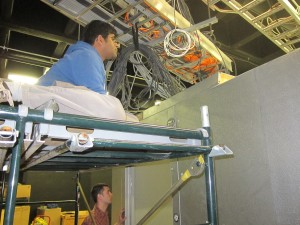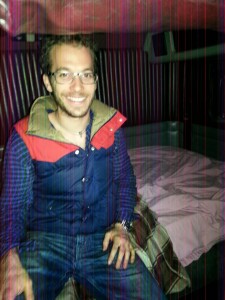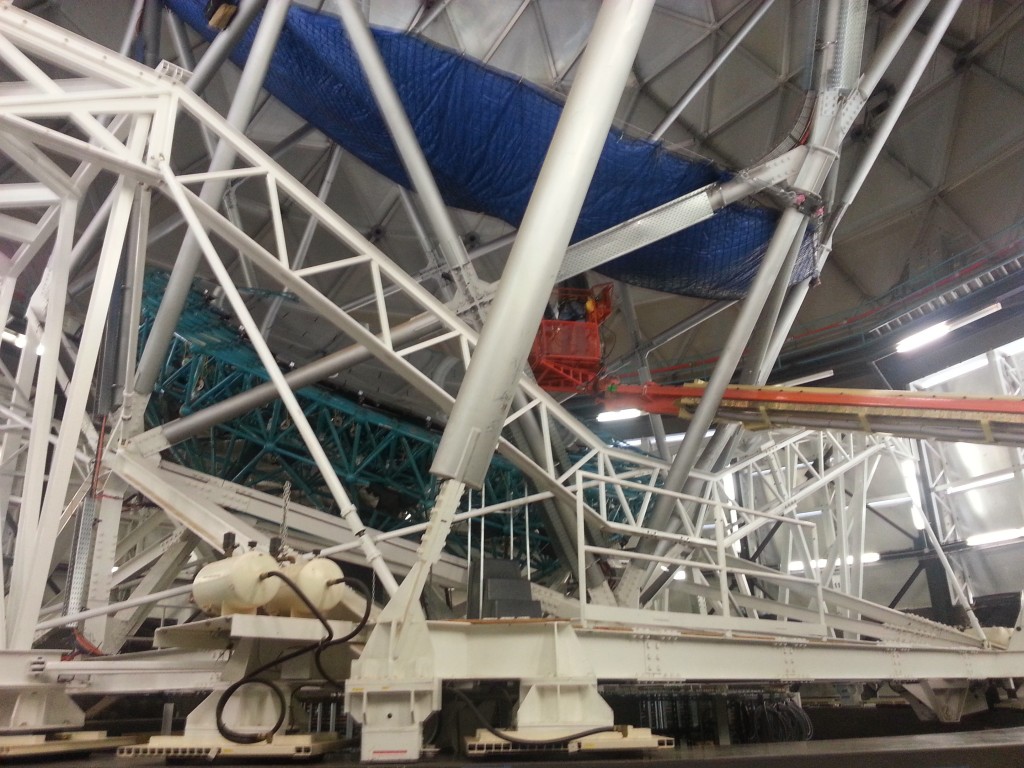HPF team members Suvrath Mahadevan, Larry Ramsey, Eric Levi, and Paul Robertson just returned from our team excursion to McDonald Observatory in west Texas. The purpose of our trip was to set up an enclosure room for our instrument calibration system, but we made time for a number of other interesting detours as well. The HET telescope is currently down while it is being upgraded to accommodate the HETDEX project, so we peeked behind the curtain of the takedown and re-assembly of the telescope. Let’s look through some pictures and highlights from the trip!
Main Mission: HPF Calibration Enclosure
To achieve the Doppler precision necessary to discover habitable planets, HPF will employ a state-of-the-art wavelength calibration system, including a laser frequency comb being developed by our NIST colleagues. While the frequency comb and the rest of the calibration system will be the subject of future posts, for now it suffices to say that the calibration equipment is a large system that must be housed in a controlled environment separately from the spectrograph itself.
The instruments installed on HET are kept in a basement below the telescope, and each one stays inside its own insulated enclosure. While one might intuitively expect these enclosures to be made of some sort of “space-age” technology, the reality is a bit more mundane. As it turns out, the same technology that keeps the meat fresh at your local butcher shop is more than adequate for insulating our instruments! Lovingly known as “meat lockers,” commercial food refrigeration units are used by HET to house its instruments. On this trip to McDonald, we laid out and assembled a “meat locker” for the HPF calibration system.

 Left: Suvrath and Paul prepare to lift the roof onto the enclosure. Right: The complete “meat locker” for the HPF calibration system.
Left: Suvrath and Paul prepare to lift the roof onto the enclosure. Right: The complete “meat locker” for the HPF calibration system.
The enclosure for the HPF spectrograph itself will be quite a bit bigger, and is being custom ordered. When it is installed, the HET basement will quickly become much more crowded!
Sightseeing at the Dismantled HET
Since the HET is down for the HETDEX installation, normal daytime operations allow for moments of looking around at the bits and pieces of the telescope that are currently undergoing maintenance and/or alteration.
The above image does a good job of illustrating the current overall state of the HET. The net/tarp above the mirror is in place to prevent objects (wrenches, bolts, people!) involved in the dismantling and re-assembly of the telescope from falling onto the mirror. Also note all the teal space around the mirror–those are normally covered with mirror segments! The segments not currently on the telescope are being cleaned and re-coated so that when science operations resume we’ll have a pristine mirror. For those remaining on the telescope, the technician on the lift is performing a regular cleaning with a carbon dioxide bath.

Logan Schoolcraft carefully and painstakingly cleans a bare Zerodur mirror segment. The HET primary mirror has 91 such segments!
New hardware for the HETDEX wide-field upgrade is in house as well. The support structure for the VIRUS spectrograph units is now mounted on the side of the telescope, but it is so big it’s difficult to photograph from the dome floor! Perhaps more exciting is the hexapod unit, which will hold the new wide-field corrector on the telescope tracker:

Eric and Paul with the new HET hexapod assembly. Thanks to the mountain staff for the pretty pink hard hats.
While the hexapod is being installed as part of the HETDEX project, it is important for HPF as well, since its role in stably tracking telescope targets is crucial for the RV stability of the spectrograph.
The (long) Voyage Home: Bringing Back MRS
In order to make room for HPF at HET, we have recently decommissioned the Medium Resolution Spectrograph or MRS. Since the instrument was built by Penn State (PI: Larry Ramsey), we had to transport the actual parts of the spectrograph back to State College. Rather than have the equipment shipped at considerable cost and risk, we rented a truck and drove the instrument home ourselves. If you thought loading your couch into a moving truck was tough, try doing the same thing with a 14-foot optical bench that weighs 2000 pounds!
Over the next few days, Eric and Paul saw quite a bit of the American landscape as they drove the truck back to State College. They were actually on pace to make the trip in just two days, but an unfortunate transmission failure extended the journey by a day and forced an extremely difficult load swap to a new truck in a Nashville parking lot.

Eric Levi rides in the sleeper section of the 18-wheeler wrecker towing our broken-down truck to a service center.
Eventually, MRS was delivered safe and sound to PSU, and the drivers got a visit to the delicious Chuy’s Mexican restaurant in Nashville for their troubles.
As you can see, building a world-class spectrograph requires quite the skill set. An extensive background in physics, engineering, construction, food storage, and truck driving is recommended!



 RSS - Posts
RSS - Posts